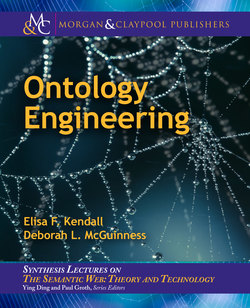Читать книгу Ontology Engineering - Elisa F. Kendall - Страница 9
На сайте Литреса книга снята с продажи.
ОглавлениеForeword by Richard Mark Soley, Ph.D.
Recently, I was speaking at a conference and spent most of the hour talking about metadata and semantics. At the end of the hour, we had some time for audience questions and answers, so I opened the floor to questions. The first question floored me: “Great speech, Dr. Soley, but I’m still hazy on one point. What do you mean by metadata?”
Great speech, indeed! I was grumpy and tired and probably hungry too. “Three!” said I, immediately drawing a reply from the confused audience member.
“Three what?” he asked.
“Congratulations,” I answered. “You’ve just reinvented metadata!”
This vignette repeats time and time again across the world as metadata, semantics and ontology swirl around every discussion of data value. “Data is the new oil!” we’re told; but it’s not. What’s important is what that data means in context. And the context is the metadata, or the (unfortunately) implied ontology governing the meaning of that data.
Defining those contexts is not a trivial thing; if it was, one of the myriad attempts over the years to define the “semantics of everything” would likely have worked. Instead of redefining Yet Another Middleware solution (as often is the case, starting with an easy or solved problem first), we’d have a way to easily connect any two or more software applications. Natural language translation would be a snap. User interfaces would be obvious!
But that hasn’t happened, and it likely won’t. Semantics of information are highly dependent on context (vertical market, application usage, time of day, you name it). Corralling data into usable information remains hard but worth the trouble. No longer will governments publish all their collected data without explaining what it means; something that has already happened!
At the Object Management Group, ontologies are of supreme importance. This three-decade-old well-established standards organization, having gone through middleware and modeling phases, is now tightly focused on vertical markets; more than three-quarters of all standards currently in development are focused on vertical markets like financial systems, retail point-of-sale systems, military command-and-control systems, manufacturing systems, and the like. The core of all of these standards are ontologies that bring orderly semantics to the syntax of the connections. And high-quality design and engineering of ontologies allows them to withstand the changing vicissitudes of markets and gives some hope that ontological (semantic) information might cross domains.
Well-engineered ontologies are therefore the cornerstone of high-quality standards. Far more than mere data models or interface definitions, an ontology leads to both; that is, if you get the semantics right, it is much more likely that your interface definitions, database metamodels—in fact, all of the artifacts that you need will almost design themselves. Some or all of the necessary artifacts forming the basis of good programming may simply “fall out” of the ontology!
I hope this gets you thinking about how to engineer a high-quality ontology that stands the test of time. You’re ready for an explanation of exactly how to do that.
Richard Mark Soley, Ph.D.
Chairman and Chief Executive Officer
Object Management Group, Inc.
